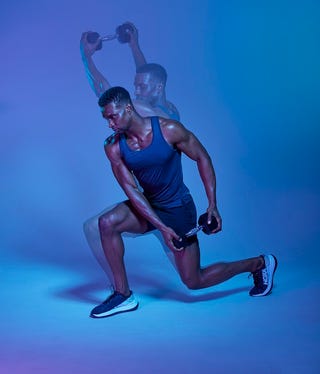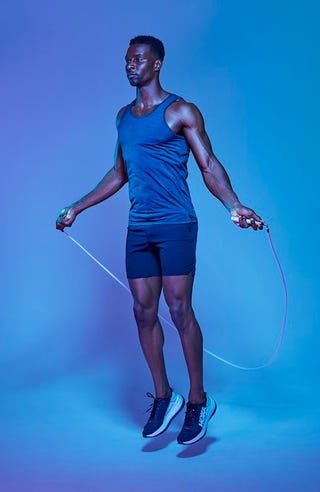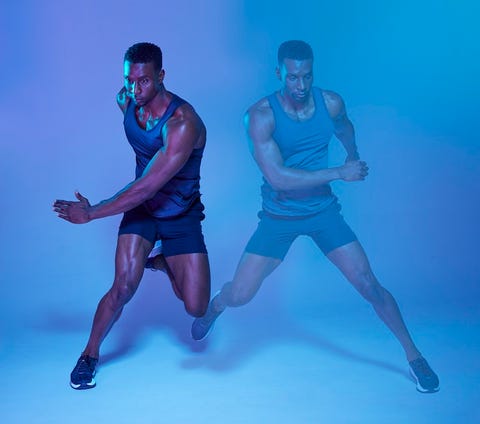Your hip flexors and quads ache, a dull pain that you’ve probably felt before, especially after training. You think you know how to deal with it. You foam roll, you do some stretches, but this only sort of fixes the achiness. That’s because the problem isn’t just about your muscles.
The real culprit: You’ve been neglecting your fascia, the fibrous tissue that was once thought to simply encase your muscles. More recently, it’s been shown to play a key role in how your body moves—and why it occasionally aches. The sooner you learn to take care of this oft-overlooked tissue, the faster you’ll bounce back from that painful hip flexor and other kinds of soreness—and the bouncier you’ll be during any activity, whether that’s running, lifting, doing errands, or goofing off with your kids.
For years, fascia was viewed as something to be kneaded and leveled (hence that roller), mostly to prevent injury and to warm up. But that’s only part of the story, says Bill Parisi, C.S.C.S., author of the book Fascia Training: A Whole-System Approach and founder of the Parisi Speed School.
Your fascia is a whole-body network, much like your muscular and cardiovascular systems. You train those systems in the gym with weights and cardio. And you should train your fascial system, too, with specific moves. If you stimulate your fascia, you can help prevent many injuries and supercharge your muscles with extra power (and yes, you also improve the way your hip flexors feel and function). “Training the fascial system is the new science of speed, power, and injury resilience,” says Parisi, who has trained athletes for 30 years.
Fascia doesn’t show up on X-rays and MRIs, the traditional ways to study soft tissues, but recent advancements in ultrasound imaging technology have enabled researchers to study fascia and how it can contribute to enhanced athletic performance and human movement. They’ve learned that the fascial system is a single, interconnected web, primarily made of collagen and fluid, that surrounds everything in your body—muscles, bones, blood vessels, and so on.
This web has multiple functions. Your fascia can tighten to lend you stability in awkward positions. (Imagine contorting to reach into the backseat of your car.) Or like a spring, it can store energy when you crouch for a jump, then help deliver extra thrust when you launch off the floor. “It’s why athletes wear compression sleeves or tights, to get that feeling of warmth, springiness, and recoil, of free energy and stability around muscles and joints,” Parisi says. “Training your fascial network creates that feeling itself.”
Skip training that stimulates the fascia (or worse, barely move for hours on end) and it revolts. It’s programmed to respond quickly: Right now microscopic fibroblast cells are crawling through your body like spiders, secreting webs of collagen that form your fascial network. If you don’t move frequently, the web stiffens your muscles, which can eventually cause posture and movement imbalances. That can lead to your typical hip-flexor tightness and general body achiness. “Collagen is laid down based on the amount of stress you put on your body,” Parisi says. Stress your fascial network the right way and it becomes better at stabilizing your body and delivering more bounce.
Your go-to move, that foam roller, can relieve fascial stiffness, but it doesn’t develop fascial strength or springiness. The solution: Challenge your fascia by integrating multiplanar moves and other drills into your workouts. Make time for this and you’ll soon feel greater power, channeling your own suit of armor.
Face Your Fascia
The moves that train your fascia aren’t new, says Parisi. But the way you do them may be. Focus on using light weights, aiming to be quick and nimble. Your goal is to challenge your fascia in multiple directions and to force the tissue to react quickly to landings and contractions. Do at least one exercise from each group every week.
Planes of Attack
Unless you’re a Cobra Kai extra, there’s a good chance you spend very little time every day twisting your torso or moving laterally. The result: Your fascial webs might not be programmed to stabilize your body when you twist. “When you pull a muscle,” says Parisi, “what causes the injury is the lack of appropriate training of the fascia.” The fix: exercises that have you twisting your body in various directions and angles, done at a variety of tempos.
Exercise 1: Shovel Squat

Stand with a dumbbell at your chest. Lower into a squat, then lower the bell. Stand, pivot your left foot inward, and swing the dumbbell over your right shoulder. Repeat on the other side. That’s 1 rep; do 3 sets of 4 to 5.
Exercise 2: Reverse Lunge to Wood Chop

Stand holding a dumbbell vertically with one hand on each end. Step back with your left foot and lower into a reverse lunge, swinging the weight first toward your right shoulder, then diagonally down to your left hip. Return to the start. That’s 1 rep; do 3 sets of 6 to 8 per side.
Check Your Pulse
Tiny pulses at the end of your range of motion stimulate fibroblasts to lay down the collagen fibers that can make you more explosive. “Pulsing is the expression and release of force,” Parisi says. Use light weights (as in half your typical training weight), and experiment with different angles.
Exercise 1: Stay-Low Pushup Pulses

Get in pushup position, hands slightly wider than shoulder width, core and glutes tight, then lower your chest to within an inch of the floor. This is the start. Now make tiny up-and-down pulses for 30 seconds. Raise your chest just an inch or two every rep. Shift your weight slightly between your hands as you do. Push back up. Do 3 sets.
Exercise 2: Pulse Romanian Deadlift

Hold dumbbells or kettlebells at your sides. Keeping the weights close to your shins, push your butt back and lower your torso, stopping before your back begins to round. Pause. This is the start. Do 30 seconds of up-and-down pulses. Shift your weight from left foot to right foot every few reps. Stand. Do 3 sets.
Bounce Back
Train your fascia to be responsive and it will cushion your muscles and joints when your body thuds into the floor—after, say, a jump. It will also act like a spring, delivering added explosive energy in any direction. Your focus: small, quick jumps in multiple directions.
Exercise 1: Jumping Rope

Grab a rope (or if you don’t have one, just do repeated jumps). Focus on keeping the jumps small and staying on the balls of your feet instead of leaping high. Do three 30-second sets.
Exercise 2: Skater Jumps

Stand in an athletic stance. Leap to the right with your right foot; land softly and leap back to the left with your left foot. Work to make each leap explosive; don’t rest on the floor. Do three 30-second sets.
A version of this story originally appears in the May 2021 issue of Men’s Health, with the title “THE FASCIA TRACK”.
Source: Read Full Article

